Christ Dies Again Each Time Were Baptized
 The Baptism of Christ by Andrea del Verrocchio and Leonardo da Vinci, c. 1475 | |
| Appointment | Early 1st century Ad |
|---|---|
| Location | Present-day Al-Maghtas, Jordan |
| Participants | Jesus, John the Baptist |
The baptism of Jesus past John the Baptist is a major event in the life of Jesus which is described in iii of the gospels: Matthew, Mark and Luke.[a] It is considered to have taken place at Al-Maghtas, also called Bethany Beyond the Jordan, today located in Jordan.
Mod biblical scholars view the baptism of Jesus past John the Baptist as a historical upshot to which a loftier degree of certainty can be assigned.[ane] [2] [iii] [4] [5] Along with the crucifixion of Jesus, biblical scholars view information technology as one of the ii historically certain facts almost him, and oft utilize it every bit the starting point for the study of the historical Jesus.[six]
The baptism is one of the events in the narrative of the life of Jesus in the canonical Gospels; others include the Transfiguration, Crucifixion, Resurrection, and Ascent.[vii] [8] Most Christian denominations view the baptism of Jesus every bit an important event and a ground for the Christian rite of baptism (see besides Acts 19:i–seven). In Eastern Christianity, Jesus' baptism is commemorated on 6 January (the Julian calendar appointment of which corresponds to 19 January on the Gregorian calendar), the feast of Epiphany.[9] In the Roman Catholic Church, the Anglican Communion, the Lutheran Churches and some other Western denominations, it is recalled on a twenty-four hours within the following calendar week, the feast of the baptism of the Lord. In Roman Catholicism, the baptism of Jesus is i of the Luminous Mysteries sometimes added to the Rosary. It is a Trinitarian feast in the Eastern Orthodox Churches.
In the Synoptic Gospels [edit]
Mark, Matthew, and Luke describe the baptism in parallel passages. In all three gospels, the Holy Spirit is depicted every bit descending upon Jesus immediately subsequently his baptism accompanied by a vocalization from Heaven, but the accounts of Luke and Mark record the voice as addressing Jesus by maxim "You lot are my beloved Son, in whom I am well pleased", while in Matthew the voice states "This is my beloved Son, in whom I am well pleased" (Matthew 3:thirteen–17; Marking 1:ix–11; Luke 3:21–23).[10] [11] [12]
Later the baptism, the Synoptic gospels depict the temptation of Jesus, where Jesus withdrew to the Judean desert to fast for forty days and nights.
Matthew [edit]
In Matthew 3:14, upon coming together Jesus, John said: "I have need to be baptized of thee, and comest thou to me?" However, Jesus convinces John to baptize him however.[12] Matthew records that the voice from heaven says "This is my beloved Son, in whom I am well pleased", only does not betoken who is addressed.
Mark [edit]
Marking's account is roughly parallel to that of Matthew, except for Matthew iii:fourteen–15 describing John's initial reluctance and eventual consent to baptize Jesus, which is not described by Mark. Mark uses an unusual give-and-take for the opening of the heavens, Greek: σχιζομένους, schizomenous, which means "tearing" or "ripping" (Mark 1:x). Information technology forms a exact thread (Leitwortstil) with the rending (ἐσχίσθη, eschisthē) of the Temple veil in Mark xv:38, inviting comparison between the ii episodes.[13]
Luke [edit]
Luke 1 begins with the birth of John the Baptist, heralded to his father Zacharias past the angel Gabriel. Six months later Gabriel appears to the Virgin Mary with an announcement of the birth of Jesus, at the Declaration. At the aforementioned, Gabriel also announces to Mary the coming nativity of John the Baptist, to her kinswoman Elizabeth, who is the married woman of Zacharias. Mary immediately sets out to visit her kinswoman Elizabeth, and stays with her until John's birth. Luke strongly contrasts the reactions of Zacharias and Mary to these two respective births; and the lives of John and Jesus are intertwined.
Luke uniquely depicts John as showing public kindness to taxation collectors and encouraging the giving of alms to the poor (as in Luke 3:11). Luke records that Jesus was praying when Heaven was opened and the Holy Spirit descended on him. Luke clarifies that the spirit descended in the "bodily form" of a pigeon, as opposed to merely "descending like" a pigeon. In Acts 10:37–38, the ministry of Jesus is described equally following "the baptism which John preached".[14]
In the Gospel of John [edit]

In John 1:29–33 rather than a directly narrative, John the Baptist bears witness to the spirit descending similar a dove.[10] [xvi]
The Gospel of John (John 1:28) specifies "Bethabara beyond Jordan", i.e., Bethany in Perea equally the location where John was baptizing when Jesus began choosing disciples, and in John 3:23 at that place is mention of further baptisms in Ænon "because there was much water at that place".[17] [18]
John 1:35–37 narrates an encounter, between Jesus and 2 of his time to come disciples, who were so disciples of John the Baptist.[xix] [20] The episode in John one:35–37 forms the first of the relationship betwixt Jesus and his future disciples. When John the Baptist chosen Jesus the Lamb of God, the "two disciples heard him speak, and they followed Jesus".[14] [21] [22] One of the disciples is named Andrew, but the other remains unnamed, and Raymond E. Brown raises the question of his being the author of the Gospel of John himself.[16] [23] In the Gospel of John, the disciples follow Jesus thereafter, and bring other disciples to him, and Acts 18:24–19:half-dozen portrays the disciples of John as eventually merging with the followers of Jesus.[16] [19]
In the Gospel of the Nazarenes [edit]
According to the non-approved Gospel of the Nazarenes, the thought of being baptized past John came from the female parent and brothers of Jesus, and Jesus himself, originally opposed, reluctantly accepted it.[24] Benjamin Urrutia avers that this version is supported by the criterion of embarrassment, since followers of Jesus would not have invented an episode in which Jesus changes his mind and comes to have someone else's programme. Plus, the story came from the customs that included the family of Jesus, who would have guaranteed the authenticity of the narrative.[25]
Location [edit]

Office of the aboriginal Madaba Map showing Bethabara east of the Jordan River
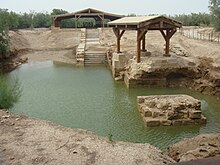
The Gospel of John (John 1:28) states that John was baptising in "Bethany Beyond the Jordan".[17] [18] mostly considered to be the town of Bethany, also called Bethabara in Perea, on the eastern banking concern of the Jordan river, well-nigh Jericho.[18] In the 3rd century Origen, who moved to the surface area from Alexandria, suggested Bethabara equally the location.[26] In the 4th century, Eusebius of Caesarea stated that the location was on the west banking company of the Jordan, and following him, the early Byzantine Madaba Map shows Bethabara as (Βέθαβαρά).[26]
The biblical baptising is related to springs and a Wadi (al-Kharrar) close to the Eastern site of the Jordan River,[27] not the Jordan itself.[28] The pilgrimage sites, important for both Christians and Jews have shifted place during history. The site of Al-Maghtas (baptism, or immersion in Standard arabic) on the East side of the River in Hashemite kingdom of jordan has been deemed the primeval identify of worship. This site was constitute post-obit UNESCO-sponsored excavations.[29] Al-Maghtas was visited by Pope John Paul II in March 2000, and he said: "In my mind I see Jesus coming to the waters of the river Hashemite kingdom of jordan not far from hither to exist baptized by John the Baptist".[30] The Muslim conquest put an cease to the Byzantine buildings on the east bank of the Jordan River, the afterward reverence took place just across the river in the W Bank at Qasr el Yahud.[31] The valley effectually the Dead Sea, which the Hashemite kingdom of jordan River flows into from the North, is also the lowest place on planet Earth.[32]
Chronology [edit]
The baptism of Jesus is by and large considered every bit the starting time of his ministry building, soon after the start of the ministry of John the Baptist.[33] [34] [35] Luke three:1–ii states that:[36] [37]
In the fifteenth year of the reign of Tiberius Caesar—when Pontius Pilate was governor of Judea ... , the word of God came to John son of Zechariah in the wilderness.
There are 2 approaches to determining when the reign of Tiberius Caesar started.[38] The traditional approach is that of assuming that the reign of Tiberius started when he became co-regent in 11 Advertising, placing the starting time of the ministry of John the Baptist around 26 AD. However, some scholars assume it to exist upon the death of his predecessor Augustus Caesar in xiv AD, implying that the ministry building of John the Baptist began in 29 Advertisement.[38]
The generally assumed dates for the start of the ministry of John the Baptist based on this reference in the Gospel of Luke are most 28–29 AD, with the ministry of Jesus with his baptism following it shortly thereafter.[36] [37] [39] [40] [41]
Historicity [edit]

Most modern scholars believe that John the Baptist performed a baptism on Jesus, and view it every bit a historical consequence to which a high degree of certainty tin exist assigned.[1] [ii] [three] [4] James Dunn states that the historicity of the baptism and crucifixion of Jesus "command nigh universal assent".[half-dozen] Dunn states that these two facts "rank so high on the 'almost impossible to doubt or deny' scale of historical facts" that they are often the starting points for the written report of the historical Jesus.[half dozen] John Dominic Crossan states that it is historically certain that Jesus was baptised by John in the Jordan.[5]
In the Antiquities of the Jews (eighteen.5.2) 1st-century historian Flavius Josephus too wrote nearly John the Baptist and his eventual death in Perea.[42] [43]
The existence of John the Baptist within the same time frame as Jesus, and his eventual execution past Herod Antipas, is attested to past 1st-century historian Flavius Josephus and the overwhelming majority of modern scholars view Josephus' accounts of the activities of John the Baptist as authentic.[44] [45] Josephus establishes a key connection between the historical events he recorded and specific episodes that appear in the gospels.[44] The reference in the Antiquities of the Jews by Josephus to John's popularity amongst the crowds (Ant xviii.5.two) and how he preached his baptism is considered a reliable historical datum.[46] [47] Dissimilar the gospels, Josephus does not relate John and Jesus, and does not country that John's baptisms were for the remission of sins.[46] [47] [48] Nonetheless, almost all modern scholars consider the Josephus passage on John to be accurate in its entirety and view the variations between Josephus and the gospels as indications that the Josephus passages are authentic, for a Christian interpolator would have made them correspond to the Christian traditions.[49] [50]
I of the arguments in favour of the historicity of the baptism of Jesus past John is that it is a story which the early Christian Church would take never wanted to invent, typically referred to every bit the criterion of embarrassment in historical analysis.[four] [5] [51] Based on this criterion, given that John baptised for the remission of sins, and Jesus was viewed as without sin, the invention of this story would have served no purpose, and would have been an embarrassment given that it positioned John above Jesus.[4] [51] [52] The Gospel of Matthew attempts to offset this trouble past having John feel unworthy to baptise Jesus and Jesus giving him permission to do then in Matthew 3:fourteen–15.[53]
The gospels are non the only references to the baptisms performed past John and in Acts x:37–38, the apostle Peter refers to how the ministry building of Jesus followed "the baptism which John preached".[54] Another statement used in favour of the historicity of the baptism is that multiple accounts refer to it, usually chosen the benchmark of multiple attestation.[53] Technically, multiple attestation does not guarantee authenticity, but only determines artifact.[55] Yet, for most scholars, together with the benchmark of embarrassment it lends credibility to the baptism of Jesus by John being a historical event.[53] [56] [57] [58]
Artistic depictions [edit]
While the gospel of Luke is explicit about the Spirit of God descending in the shape of a pigeon, the wording of Matthew is vague enough that it could be interpreted only to advise that the descent was in the style of a dove. Although a variety of symbolisms were fastened to doves at the fourth dimension these passages were written, the dove imagery has get a well known symbol for the Holy Spirit in Christian fine art.[59] [threescore] Depictions of the baptismal scene typically show the sky opening and the Holy Spirit descending every bit a dove towards Jesus.[61]
Artists unremarkably tried to show the whole body of Christ as he stood in the h2o, which could give them difficulties. The reasonably coherent 6th-century mosaic image in the Arian Baptistry, Ravenna, with the h2o hemmed in by two banks, when used in many generations of copies in Western Europe, by artists unskilled in depicting visual recession, led to images like that in the Psalter of Eleanor of Aquitaine, where at that place appears to be a standing mound of h2o.
At least i attendant archangel, property Christ's robe, and often another with a towel, became usual in medieval images.
-
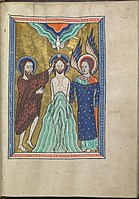
Miniature from the Psalter of Eleanor of Aquitaine (ca. 1185)
-

-
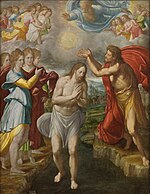
-
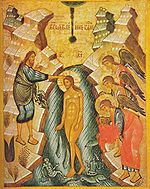
-

-

-

Relief in Kärlich, around the 17th century
-
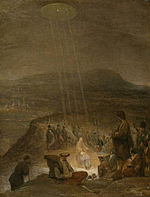
-

-

Giovanni Battista Tiepolo, Baptism of Christ, 18th century, Italia
Music [edit]
The reformer Martin Luther wrote a hymn nigh baptism, based on biblical accounts well-nigh the baptism of Jesus, "Christ unser Herr zum Hashemite kingdom of jordan kam" (1541). It is the basis for a cantata by Johann Sebastian Bach, Christ unser Herr zum Hashemite kingdom of jordan kam, BWV seven , first performed on 24 June 1724.
Come across too [edit]
- Ænon
- Al Maghtas
- Bethabara
- Chronology of Jesus
- Jesus in Christianity
- Life of Jesus in the New Attestation
- Mandaeism
- Ministry of Jesus
- New Testament places associated with Jesus
- Qasr el Yahud
- Transfiguration of Jesus
Notes [edit]
- ^ The Gospel of John does non directly describe Jesus' baptism.
It is traditionally celebrated on the Sunday after Epiphany, oscillating between January 7 and thirteen, however, different episcopal conferences celebrate it in the same mode, only the deviation is that this party is merely celebrated on the Dominicus afterwards Epiphany, oscillating between the 9 and on January 13, if Christmas falls on Monday, Holy Family on December 31, the Solemnity of Saint Mary, Mother of God on Monday, this feast volition exist celebrated on Mon, 8 January and if Christmas falls on Sunday, the Solemnity of Saint Mary, Mother of God on Lord's day, this feast happens to exist historic on Monday, January ix.
References [edit]
- ^ a b The Gospel of Matthew by Daniel J. Harrington 1991 ISBN 0-8146-5803-2 p. 63
- ^ a b Christianity: A Biblical, Historical, and Theological Guide past Glenn Jonas, Kathryn Muller Lopez 2010, pp. 95–96
- ^ a b Studying the Historical Jesus: Evaluations of the Country of Electric current Enquiry by Bruce Chilton, Craig A. Evans 1998 ISBN 90-04-11142-5 pp. 187–98
- ^ a b c d Jesus equally a Figure in History: How Mod Historians View the Man from Galilee by Mark Allan Powell 1998 ISBN 0-664-25703-8 p. 47
- ^ a b c Who Is Jesus? past John Dominic Crossan, Richard G. Watts 1999 ISBN 0-664-25842-v pp. 31–32
- ^ a b c Jesus Remembered by James D. M. Dunn 2003 ISBN 0-8028-3931-2 p. 339
- ^ Essays in New Attestation Interpretation by Charles Francis Digby Moule 1982 ISBN 0-521-23783-1 p. 63
- ^ The Melody of Faith: Theology in an Orthodox Central by Vigen Guroian 2010 ISBN 0-8028-6496-ane p. 28
- ^ Богоявление и Рождество Христово
- ^ a b Jesus of History, Christ of Faith by Thomas Zanzig 2000 ISBN 0-88489-530-0 p. 118
- ^ Eerdmans Commentary on the Bible past James D. K. Dunn, John William Rogerson 2003 ISBN 0-8028-3711-5 p. 1010
- ^ a b The Synoptics: Matthew, Marking, Luke by Ján Majerník, Joseph Ponessa, Laurie Watson Manhardt 2005 ISBN 1-931018-31-6 pp. 27–31
- ^ David Rhoads, Joanna Dewey, and Donald Michie 2012, Mark as Story: An Introduction to the Narrative of a Gospel, third ed. Minneapolis, MN: Fortress Printing, 48.
- ^ a b Jesus of Nazareth by Duane South. Crowther 1999 ISBN 0-88290-656-9 p. 77
- ^ The Lamb of God past Sergei Bulgakov 2008 ISBN 0-8028-2779-9 p. 263
- ^ a b c The Gospel and Epistles of John: A Concise Commentary by Raymond Edward Brown 1988 ISBN 978-0-8146-1283-5 pp. 25–27
- ^ a b Large Picture of the Bible – New Testament by Lorna Daniels Nichols 2009 ISBN ane-57921-928-four p. 12
- ^ a b c John past Gerard Stephen Sloyan 1987 ISBN 0-8042-3125-7 p. 11
- ^ a b The People'south New Testament Commentary by Eugene M. Dull and Fred B. Craddock 2010, Westminster John Knox Press ISBN 0-664-23592-ane pp. 292–93
- ^ New Testament History by Richard L. Niswonger 1992 ISBN 0-310-31201-9 pp. 143–46
- ^ The Life and Ministry of Jesus: The Gospels by Douglas Redford 2007 ISBN 0-7847-1900-four p. 92
- ^ A Summary of Christian History by Robert A. Bakery, John M. Landers 2005 ISBN 0-8054-3288-4 pp. 6–7
- ^ The Disciple Whom Jesus Loved by J. Phillips 2004 ISBN 0-9702687-ane-8 pp. 121–23
- ^ Jerome, quoting "The Gospel According to the Hebrews" in Dialogue Against Pelagius III:two.
- ^ Guy Davenport and Benjamin Urrutia, The Logia of Yeshua / The Sayings of Jesus (1996), ISBN 1-887178-70-8 p. 51.
- ^ a b Jesus and Archaeology by James H. Charlesworth 2006, Eedrsmans ISBN 0-8028-4880-Ten pp. 437–39
- ^ The Synoptics past Jan Majernik, Joseph Ponessa and Laurie Manhardt 2005 ISBN 1-931018-31-vi p. 29
- ^ "Wo Johannes taufte". ZEIT ONLINE. Rosemarie Noack. 22 December 1999. Retrieved ix December 2015.
- ^ Staff writers (28 July 2011). "Israel will reopen (Israeli) site of the baptism of Jesus". AsiaNews.it . Retrieved 31 July 2011.
- ^ Vatican website: Address of John Paul II at Al-Maghtas Archived 16 July 2012 at the Wayback Machine
- ^ "No evidence, only Un says Jesus baptized on Jordan'southward side of river, not Israel's". The Times of Israel. 13 July 2015. Retrieved 26 November 2015.
- ^ "Everyman Places on Earth - Death Valley National Park (U.South. National Park Service)". www.nps.gov . Retrieved 14 September 2020.
- ^ Jesus and the Gospels: An Introduction and Survey by Craig L. Blomberg 2009 ISBN 0-8054-4482-3 pp. 224–29
- ^ Christianity: An Introduction by Alister East. McGrath 2006 ISBN 978-1-4051-0901-7pp. sixteen–22
- ^ The Cradle, the Cross, and the Crown: An Introduction to the New Testament by Andreas J. Köstenberger, L. Scott Kellum 2009 ISBN 978-0-8054-4365-3 po. 140–41
- ^ a b Eerdmans Dictionary of the Bible 2000 Amsterdam University Press ISBN 90-5356-503-5 p. 249
- ^ a b The Bible Knowledge Background Commentary: Matthew-Luke, Volume 1 by Craig A. Evans 2003 ISBN 0-7814-3868-3 pp. 67–69
- ^ a b Luke 1–five: New Testament Commentary by John MacArthur 2009 ISBN 0-8024-0871-0 p. 201
- ^ The Cradle, the Cross, and the Crown: An Introduction to the New Attestation by Andreas J. Köstenberger, L. Scott Kellum 2009 ISBN 978-0-8054-4365-3 p. 114
- ^ Christianity and the Roman Empire: Background Texts by Ralph Martin Novak 2001 ISBN 1-56338-347-0 pp. 302–03
- ^ Hoehner, Harold W (1978). Chronological Aspects of the Life of Christ. Zondervan. pp. 29–37. ISBN0-310-26211-9.
- ^ Eerdmans Dictionary of the Bible 2000 ISBN 90-5356-503-five p. 583
- ^ Behold the Homo: The Real Life of the Historical Jesus by Kirk Kimball 2002 ISBN 978-1-58112-633-4 p. 654
- ^ a b Craig Evans, 2006 "Josephus on John the Baptist" in The Historical Jesus in Context edited by Amy-Jill Levine et al. Princeton Univ Press ISBN 978-0-691-00992-vi pp. 55–58
- ^ The New Complete Works of Josephus by Flavius Josephus, William Whiston, Paul L. Maier ISBN 0-8254-2924-2 pp. 662–63
- ^ a b John the Baptist: Prophet of Purity for a New Age past Catherine M. White potato 2003 ISBN 0-8146-5933-0 p. 53
- ^ a b Jesus & the Rise of Early Christianity: A History of New Testament Times past Paul Barnett 2009 ISBN 0-8308-2699-8 p. 122
- ^ Claudia Setzer, "Jewish Responses to Believers in Jesus", in Amy-Jill Levine, Marc Z. Brettler (editors), The Jewish Annotated New Testament, p. 576 (New Revised Standard Version, Oxford Academy Printing, 2011). ISBN 978-0-xix-529770-6
- ^ Evans, Craig A. (2006). "Josephus on John the Baptist". In Levine, Amy-Jill. The Historical Jesus in Context. Princeton Univ Press. ISBN 978-0-691-00992-6. pp. 55–58
- ^ Boil, Paul; Boyd, Gregory (2007). The Jesus Legend: A Example for the Historical Reliability of the Synoptic Jesus Tradition. ISBN 0-8010-3114-1. p. 130
- ^ a b Jesus of Nazareth: An Independent Historian's Account of His Life and Education by Maurice Casey 2010 ISBN 0-567-64517-7 p. 35
- ^ The Historical Jesus: a Comprehensive Guide by Gerd Theissen, Annette Merz 1998 ISBN 0-8006-3122-6 p. 207
- ^ a b c John the Baptist: Prophet of Purity for a New Historic period by Catherine M. Spud 2003 ISBN 0-8146-5933-0 pp. 29–xxx
- ^ Who is Jesus?: An Introduction to Christology by Thomas P. Rausch 2003 ISBN 978-0-8146-5078-three p. 77
- ^ Jesus and His Contemporaries: Comparative Studies by Craig A. Evans 2001 ISBN 0-391-04118-5 p. 15
- ^ An Introduction to the New Testament and the Origins of Christianity by Delbert Royce Burkett 2002 ISBN 0-521-00720-8 pp. 247–48
- ^ Who is Jesus? by Thomas P. Rausch 2003 ISBN 978-0-8146-5078-three p. 36
- ^ The Relationship between John the Baptist and Jesus of Nazareth: A Disquisitional Written report by Daniel S. Dapaah 2005 ISBN 0-7618-3109-6 p. 91
- ^ Clarke, Howard W. The Gospel of Matthew and its Readers: A Historical Introduction to the First Gospel. Bloomington: Indiana University Press, 2003.
- ^ Albright, W.F. and C.South. Isle of man. "Matthew". The Anchor Bible Series. New York: Doubleday & Visitor, 1971.
- ^ Medieval Art: A Topical Dictionary past Leslie Ross 1996 ISBN 978-0-313-29329-0 p. thirty
External links [edit]
- Baptism of Jesus – Cosmic Encyclopedia
morrowsleasedgered61.blogspot.com
Source: https://en.wikipedia.org/wiki/Baptism_of_Jesus